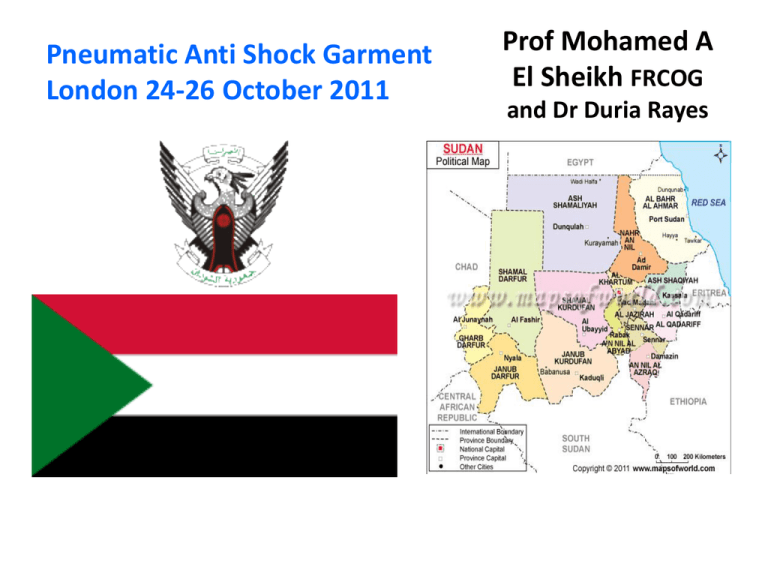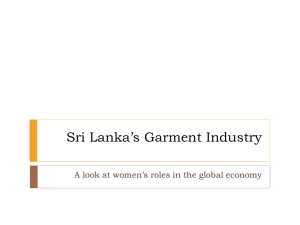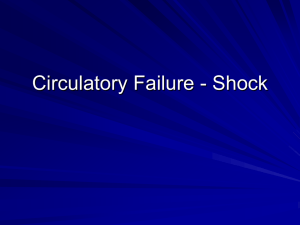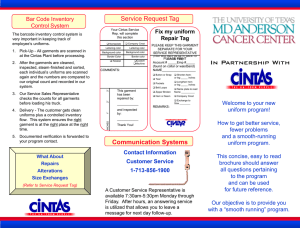obstetric haemorrhage
advertisement

Pneumatic Anti Shock Garment London 24-26 October 2011 Prof Mohamed A El Sheikh FRCOG and Dr Duria Rayes Pneumatic Anti Shock Garment London 24-26 October 2011 Prof Mohamed A El Sheikh FRCOG The Millennium Development Goals Eight Goals for 2015 1 Eradicate extreme poverty and hunger 2 Achieve universal primary education 3 Promote gender equality and empower women 4 Reduce child mortality 5 Improve maternal health 6 Combat HIV/AIDS, malaria and other diseases 7 Ensure environmental sustainability 8 Develop a global partnership for development Maternal Mortality • Every year, an estimated 529,000 women die from complications of pregnancy and childbirth; • 99% of these deaths occur in developing countries. • For every woman who dies, there are 30 women who suffer a maternal morbidity and 10 who experience ‘near miss mortality’ (a life threatening obstetric complication) Postpartum haemorrhage (PPH), • Defined as vaginal bleeding in excess of 500mL after vaginal delivery and in excess of 1000mL after caesarean delivery • The most common cause of obstetric haemorrhage. • One of the five leading causes of maternal mortality in developed and developing countries, • A WOMAN dies every 4 minutes from PPH Maternal mortality due to PPH Many women in rural areas, where hospitals may be days away, are transported over long distances to the “nearest” hospital, and, if they survive the trip, often encounter additional delays in receiving appropriate treatment. Also, in areas that have limited resources, clinics and hospitals might not have the staff or supplies needed to save a woman's life. Maternal mortality due to PPH When delays occur, a woman can bleed enough to go into shock. Unless this is reversed, her vital organs, including the kidney, heart, lungs and brain, can be irreversibly damaged. A bleeding woman who develops hypovolaemic shock from PPH can die within 2 hours. Women die waiting for treatment. Maternal mortality due to PPH TOO LATE ……. TOO LITTLE Delay in transport Too Little (IV fluids, oxytocics, BLOOD, Clotting factors) Too Late (PG, resuscitation - blood replacement, decision for surgery + to get senior surgeon & anaesthetist involved) Obstetric Haemorrhage can be managed in developed countries with uterotonic medications, blood transfusions, and surgery, is often fatal in developing countries where a large percentage of births occur at home where there is limited access to high quality Comprehensive Emergency Obstetric Care (CEmOC) New strategies or technologies that can reduce this burden of disease will greatly contribute to improved health of women, families, communities and nations The Anti-Shock Garment (ASG) • is a generic term for any compression device that shunts blood from the extremities to the core organs, heart, lung, and brain, thus reversing shock. • In the 1903 an inflatable pressure suit was developed to decrease postural hypotension in neurosurgical patients (George W Crile • In the 1940s and after undergoing numerous modifications, the suit was refined for use as an anti-gravity suit (G-suit). The Anti-Shock Garment (ASG) Further modification led to its use in the Vietnam War for resuscitating and stabilizing soldiers with traumatic injuries before and during transportation. In the 1970s the G-suit was modified into a half-suit which became known as MAST (Military anti-shock trousers) or PASG (Pneumatic Anti-Shock Garment). THE MILITARY TROUSERS The Anti-Shock Garment (ASG) In 1979, the PASG was useful for temporary management of massive obstetric haemorrhage in four women with ectopic pregnancies awaiting surgery. (Hall and Marshall) During the 1980s the PASG garment was used by emergency rescue services to stabilize patients with shock due to lower body haemorrhage. In 1993, the PASG was used in the management haemorrhage in two women with abdominal pregnancies (Sandberg and Pelligra) The Anti-Shock Garment (ASG) In 1999, Bengt et al. its use as a temporary measure before definitive radiological intervention in two women with uterine bleeding. During the 1990s the PASG was added to the American College of Obstetrics and Gynaecology, making it part of the recommended treatment for use by obstetricians and gynaecologists in the USA. Non-pneumatic Anti-Shock Garment (NASG), From the 1970s, NASA/AMES developed a nonpneumatic version of the anti-shock garment. This was originally used for haemophiliac children, but has since been developed into the garment known as the Non-pneumatic Anti-Shock Garment (NASG), which has been used for a variety of indications since the mid 1970s. Non-pneumatic Anti-Shock Garment (NASG), In 2002 when Brees and Hensleigh introduced the garment for obstetrical haemorrhage into a hospital in Pakistan and reported on a case series of its use. Miller and colleagues in Mexico, Egypt and Nigeria have completed studies of the NASG (also named the Life Wrap) for obstetric haemorrhage in hospitals in these countries with studies ongoing at primary health care centres in Zambia and Zimbabwe. The Non-Pneumatic Anti-Shock garment (NASG) is a simple lightweight, relatively inexpensive washable and reusable compression suit, comprising five neoprene segments that close tightly with Velcro around the legs, pelvis and abdomen designed to allow perineal access so that examinations and vaginal procedures can be performed without it being removed. The NASG reverses shock by returning blood to the heart, lungs and brain enhancing organ perfusion before definitive treatment is available. This restores the woman's consciousness, pulse and blood pressure. The Non-Pneumatic Anti-Shock garment (NASG) It is postulated that the NASG reverses the hypotension by at least three different mechanisms: • By increasing peripheral vascular resistance, • By a tamponade effect on intra-abdominal bleeding and • By auto transfusion of blood from the lower extremities and abdomen to the head and upper trunk. The Non-Pneumatic Anti-Shock garment (NASG) only applies 30–40 mmHg play an important role in overcoming delays that contribute to unnecessary deaths from obstetric haemorrhage. The NASG is NOT recommended for use with: a viable foetus, patients with mitral stenosis, congestive heart failure, pulmonary hypertension, in clinical conditions where there could be bleeding sites above the level of the diaphragm. Non-pneumatic anti-shock garment (NASG) on blood loss from obstetric haemorrhage Research has been carried out in Egypt and Nigeria and is ongoing in Zimbabwe and Zambia 50% decrease in measured blood loss after entry (250 Vs 500 ml) who were treated with NASG compared to those treated with standard protocol. Source: Suellen Miller Promising results Significant reduction in blood loss and improved resuscitation time Trend toward reduction in morbidity and mortality Additional research Continuing pre/post studies in Nigeria & Egypt Randomized Cluster Controlled Trial in Zambia and Zimbabwe Objective To evaluate the feasibility, safety and effectiveness of the non-pneumatic antishock garment for resuscitation and haemostasis following obstetric haemorrhage resulting in severe shock. To determine whether the non-pneumatic anti-shock garment (NASG) can improve maternal outcome. Design of the Study A non-randomized preintervention/intervention study ??? Comparative study ???? Observational study ???? Randomised controlled study??? Cluster randomised controlled study. (This needs further discussion) • SETTING: multicentre international study Study Population Entry criteria are: • obstetric haemorrhage ( clinically estimated as ≥750 mL) • A clinical sign of shock (systolic blood pressure <100 mm Hg or pulse >100 beats per minute). • (Exclusion criteria? ) Primary Outcomes Measured mean and median blood loss, Severe end-organ failure morbidity (renal failure, pulmonary failure, cardiac failure, or CNS dysfunctions), Mortality, Emergency hysterectomy. (Others???) METHODS All women who satisfy the criteria are admitted to the study. The standard resuscitation measures were done. The NASG is then applied on the patient as soon as there is clinical evidence of severe haemorrhage or shock. Clinical observations include pulse, blood pressure and respiratory rates every 15-30 minutes; oxygen saturation is obtained intermittently as clinically indicated and a Foley’s catheter is inserted to determine the urine output. METHODS Fluid resuscitation included rapid saline infusion of 1.5 times the estimated blood loss and blood transfusion when available. When the pulse and the blood pressure return to baseline and the condition of the patient is stable the NASG is removed in segments, beginning at the ankles and sequentially removing the panels upwards at15-min intervals with observation for recurrent hypotension or tachycardia. Statistical Methods statistical methods need to be reviewed? t tests and chi(2) tests. Comparisons of outcomes are assessed with rank sum tests, relative risks (RR) and 95% confidence inter, number needed to treat for benefit (NNTb), and multiple logistic regression METHODS • In cluster randomized controlled trial the methodology is different, that needs further discussion (Zambia / Zimbabwe study as an example; (currently ongoing study) MILLENIUM DEVELOPMENT MILLENIUM DEVELOPMENT GOALS GOALS THANK YOU THANK YOU Discussion Confirms larger study in Egypt 1 NASG Group has better outcomes, despite entering study in worse condition Limitations Small sample size No contemporary controls (pre/post) Groups were statistically significantly different in parity In some of these hospitals, a lack of blood and fluids limits successful outcomes 1 Miller S, Hamza S, Bray E, Lester F, Nada K, Gibson R, Fathalla M, Mourad M, Fathy A, Tuan J, Dau K, Nasshar I, Elshair I, Hensleigh P. First aid for obstetric haemorrhage: the pilot study of the non-pneumatic anti-shock garment in Egypt. BJOG: 2006. Rule of 30 & Shock Index 30% blood loss >moderate shock Pulse rate – increase >30 bpm Respiratory rate >30/min Systolic BP – drop by 30 mm Hg Urinary output < 30 ml/hour Haematocrit drop > 30% & to be kept at an absolute value of > 30 Shock Index = Pulse rate / Systolic BP – Change by 30% Normal = 0.5 to 0.7 : >0.9 indicates state of shock that needs urgent resuscitation PPH - Old problem – Innovative Approaches HAEMOSTASIS & Rule of 30 PG potentiates the action of oxytocin Anti-shock Garment Tamponade test - Therapeutic & Diagnostic Uterine Compression Sutures Body weight – Blood volume & Hb% ‘Wash Out’ phenomenon - fibrinogen/ r-Factor VII Severe Shock & Golden Hour - Definitive Surgery






